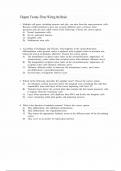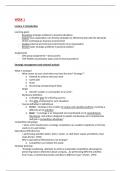Kosala Madhushanka
september 2024
1 Definition and Types of Differential Equations
A differential equation is an equation that involves an unknown function and
its derivatives. Ordinary differential equations (ODEs) involve functions of one
independent variable and their derivatives.
2 Separable Differential Equations
2.1 Definition
A first-order ODE is separable if it can be written in the form
dy f (x)
= .
dx g(y)
2.2 Solution Method
• Separate the variables:
dy
= f (x)dx.
g(y)
• Integrate both sides: Z Z
dy
= f (x)dx.
g(y)
3 Initial Conditions
3.1 Definition
An initial condition specifies the value of the solution at a particular point.
3.2 Initial Value Problem
A differential equation together with an initial condition is known as an initial
value problem.
1
, 3.3 Solving Initial Value Problems
1. Solve the differential equation.
2. Apply the initial condition to find the particular solution.
4 Exponential Growth and Decay Models
The separable differential equation for exponential growth and decay is
dy
= k · y.
dx
The solution is
y(x) = c · ekx ,
where c is a constant determined by the initial condition.
5 Homogeneous and Non-Homogeneous Differ-
ential Equations
5.1 Homogeneous Differential Equation
A differential equation is homogeneous if it equals zero when both sides are
divided by the highest order derivative.
5.2 Non-Homogeneous Differential Equation
A differential equation is non-homogeneous if it is not homogeneous.
6 Identifying and Solving First-Order Differen-
tial Equations
1. Identify the type of differential equation.
2. Apply the appropriate solution method.
3. If the differential equation is separable, solve it using separation of vari-
ables.
7 Undetermined Coefficient Method for Non-
Homogeneous Equations
A method for finding particular solutions to non-homogeneous equations in-
volves guessing a form for the particular solution and solving for the coefficients.
2










